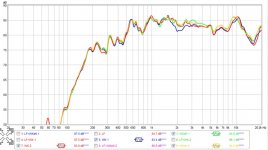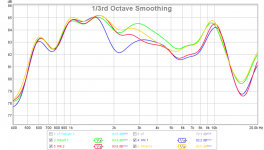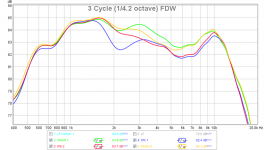It is strange that making the cone heavier is not decreasing sensitivity. All else being the same, a heavier cone should result in lower sensitivity, right? Can you measure your second pair of drivers also?
Also, you can see that many of the bumps and troughs are the same in all three drivers. These are not driver resonances, but reflections created due to the setup. For example, the series of bumps from about 1.4 kHz to 2 kHz, the dip at 5.5 kHz, etc. There are others. Note that the bump around 9 kHz is only in the two Fostex drivers, so that one is not setup related.
To my eyes, other than the shelf above about 2 kHz, there is almost no difference between the two Fostex drivers. But this difference will be audible and I'm not sure this pair of drivers lends itself to a good comparison of the effects of "enable."
I was originally under the impression that the only thing the "enabled" driver will have is the dots. If it has other mods, such as damping the cone, and doing things to the surround, frame, etc., then it is not considered simply "enabling" and in which case, we should ask whether it should be part of the test for the audibility of the "enable" method.
Thanks post think you have good points that most the difference is about the 2kHz shelve, much else looks particular baffle system setup related.
Here is a sound clip of the Dagger and RS225 FAST speaker (passive XO) so you can get a sense of what they sound like. Recorded with UMM-6 mic at 0.5m away (same position and same mic as measurement). Change .asc extension to .mp3 to hear. Recording made with Audacity to 44.1kHz wave file, then converted to 320kbps MP3. I should add that the source was only playing through the right channel (so any info on left channel is lost).
Thanks clip for me it sounds natural relaxed in a good warm sound picture with forward mid and kind of little bit weak treble section. Treble section surprise me because planet10 often recommend MA drivers and sound clips from those are very different from this FF85WKeN sound clip, although it should be noted that particular track is unknown to me so have no reference other than intuition.
In general on posted data so far think FF85WKeN looks bit better than stock driver so will praise planet10 skills in this regard even there is more to his mods than just the dots, what i don't get then is it looks many his mods is based on measurements and better data so why in heaven all the discussions in past here at forum and over at MA forum when people was getting bad real world data, then we was told to trust the experienced members and sonics and not the measurements and this confuses me when a FF85KeN actually show closer to textbook smooth data.
There is a constant 1 dB gain from 2 kHz upwards (post #204) - that is more than 3 octaves. Very easy to hear, it is just like turning an amplifier treble control a little bit up - "more detail" instantly!I disagree with you on many points. First off, I doubt the effect of the EnABL is significant and easy to measure and hear. Some of the measurements here indicate a 1.5 dB difference across a pretty narrow frequency range. That's audible, but is it easy to pick out?
Secondly, the dots themselves have to make a difference.
The dots themselves have to have some amount of mass, hence, they'll change the moving mass of the diaphragm.
Tom
Combined mass of the dots is significantly lower than the mass of the conformal coating applied on the whole cone - just look at the combined area of the dots regarding the area of the cone (assuming the same thickness).
I do believe that modifications done by planet10 are liked by the majority of the listeners, but I deeply disagree that the dots are helping that. Conformal coating of the cone, termination cone/surround damping and shaping the rear exit are sound ideas and are done many times before with a good results. IMHO dots are selling point only, without any improvements/difference on measurement and sound. At last, increasing the thickness of the conformal cone coating will result in exactly the same mass as mass of dots combined with regular coating, hence no reason to paint dots at all.
Treble section surprise me because planet10 often recommend MA drivers and sound clips from those are very different from this FF85WKeN sound clip, although it should be noted that particular track is unknown to me so have no reference other than intuition.
To be fair to P10, he has recommended the Fostex FF85WK many times in the 3" driver category. Also a few of his FAST designs incorporate the FF85WK (Tysen, EL166 MTM) . IIRC both P10 and ChrisB use Fonken and uFonken with FF85WKeN in personal setups (may be they can confirm). 🙂
Sonce,
So basically a consensus is forming around:
1. P10 treatments (coating, basket mods + dots) changes the driver sonics slightly, and the changes are (probably) liked/preferred by most listeners
2. P10 treatments look good (to most folks), praiseworthy craftsmanship from Dave 🙂
3. The effect of the EnABLe "dots" and "patterns" are still not convincing... only anecdotal claims from Dave and others are there that the pattern has a contribution to improvement in sound.
Dave,
For EnABLe treatment of aluminum cones, do you apply any coatings or apply the EnABLe pattern only?
So basically a consensus is forming around:
1. P10 treatments (coating, basket mods + dots) changes the driver sonics slightly, and the changes are (probably) liked/preferred by most listeners
2. P10 treatments look good (to most folks), praiseworthy craftsmanship from Dave 🙂
3. The effect of the EnABLe "dots" and "patterns" are still not convincing... only anecdotal claims from Dave and others are there that the pattern has a contribution to improvement in sound.
Dave,
For EnABLe treatment of aluminum cones, do you apply any coatings or apply the EnABLe pattern only?
Last edited:
How about listening / tests with this driver at each stage of the total treatment?
Testing the 'whole' says something done make a change - but what bit of something done?
Till 'those tests' are done, guessing is guessing......
Testing the 'whole' says something done make a change - but what bit of something done?
Till 'those tests' are done, guessing is guessing......
For EnABL treatment of aluminum cones, do you apply any coatings or apply the EnABL pattern only?
The Al alloy Mark Audio Alpairs get nothing but EnABL.
dave
How about listening / tests with this driver at each stage of the total treatment?
One of the 1st things we did. Treated drivers with each set separately and combined (3 sets of drivers)
dave
I do believe that modifications done by planet10 are liked by the majority of the listeners, but I deeply disagree that the dots are helping that.
Until you listen you are only guessing. The spots are essential.
dave
How about listening / tests with this driver at each stage of the total treatment?
Testing the 'whole' says something done make a change - but what bit of something done?
Till 'those tests' are done, guessing is guessing......
One of the 1st things we did. Treated drivers with each set separately and combined (3 sets of drivers)
dave
Wennay f' 'u.... 😉
I may make a quick uFonken out if foam core and we can test the full range capability of both drivers without help of a woofer or passive crossover.
It would be interesting to try transparent enamel rather than coloured enamel and see if people still prefer the EnABL...
Tom
Tom
It would be interesting to try transparent enamel rather than coloured enamel and see if people still prefer the EnABL...
That is how Bud does all of his, and i have done more than a few that way. Without the visual feedback i don't usually do as tidy a job.
dave
I discovered the cause of my anomalous step response measurements with the FAST setup. I recently switched to a new computer and the on-board DAC seems to have a huge bass boost EQ built in that I cannot get rid of. Using an external USB DAC solved it and the speaker measures very well now.
More info in the speaker build thread:
http://www.diyaudio.com/forums/full-range/292130-ff85wk-rs225-8-passive-fast-5.html#post4736469
XO plot:
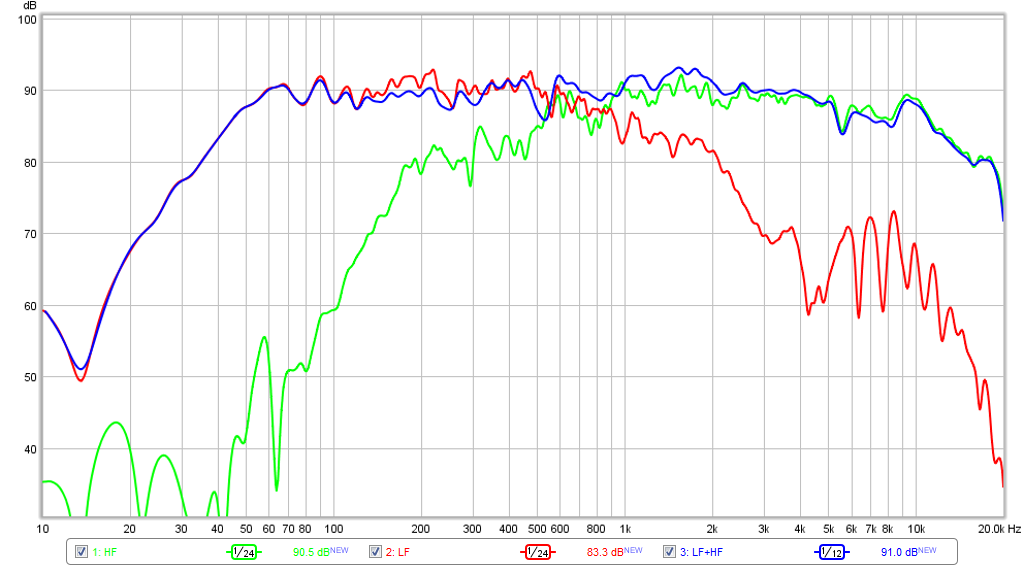
Phase:
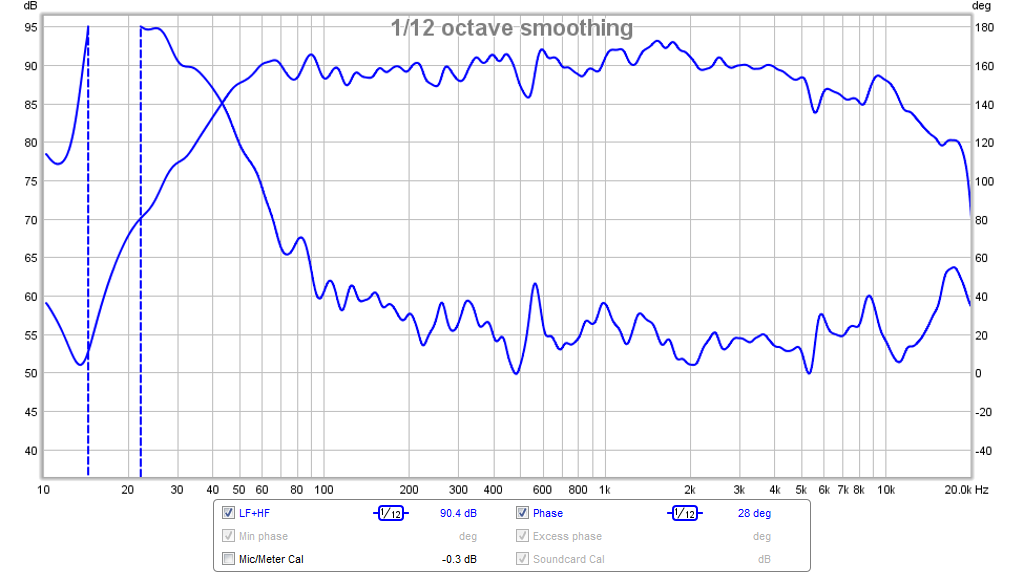
Distortion:
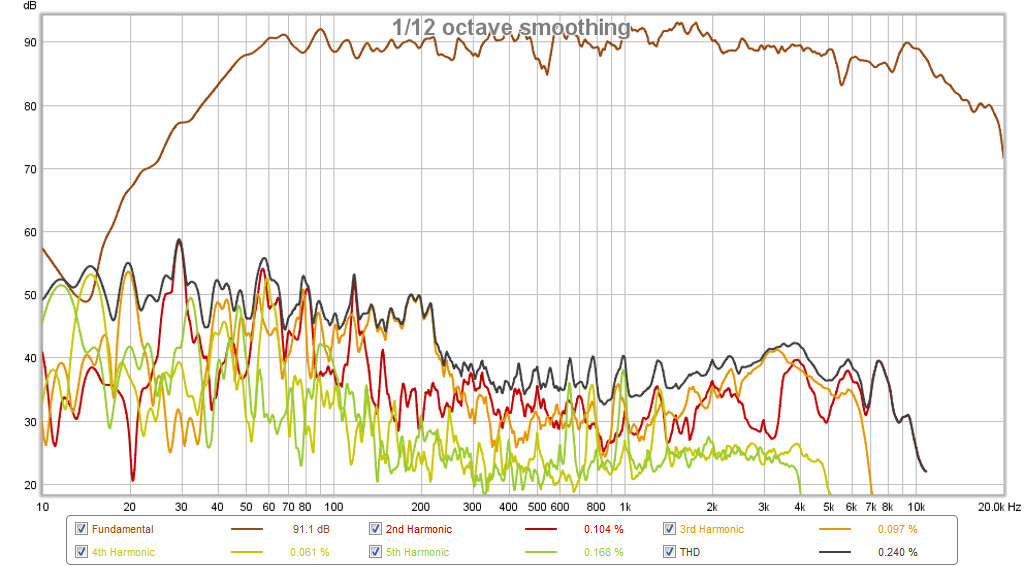
Impulse/Step Response:
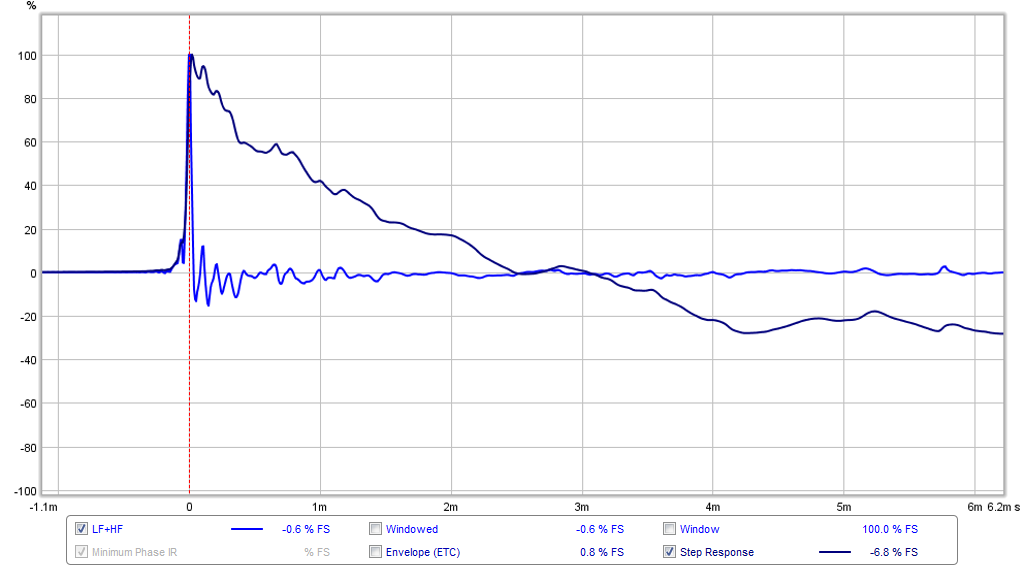
The results are excellent for a simple passive XO speaker. I need to check why the HF droops.
Here is the factory measured response:
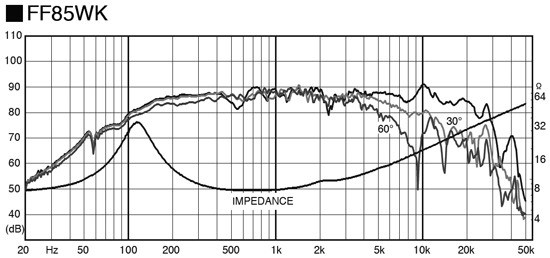
It almost looks like the measurement is off axis.
More info in the speaker build thread:
http://www.diyaudio.com/forums/full-range/292130-ff85wk-rs225-8-passive-fast-5.html#post4736469
XO plot:

Phase:

Distortion:

Impulse/Step Response:

The results are excellent for a simple passive XO speaker. I need to check why the HF droops.
Here is the factory measured response:

It almost looks like the measurement is off axis.
Last edited:
I switched to the UMIK-1 microphone and it seems to bring the HF response up a bit to match the factory curve better. Here is the comparison between both eN's and both stock pristine drivers. It seems the first one is a bit lower in sensitivity that the second. Overall, the Planet10 treated eN's are still a bit more sensitive and have a 10k peak that is shifted to the left.
Measurements taken at 0.5m, with 2.83v excitation from UCA202 DAC driving VFET+ class AB MOSFET amp fed with 300VA 45V linear power supply, passive XO, all taken in same session.
High Resolution (1dB vertical scale) comparison:
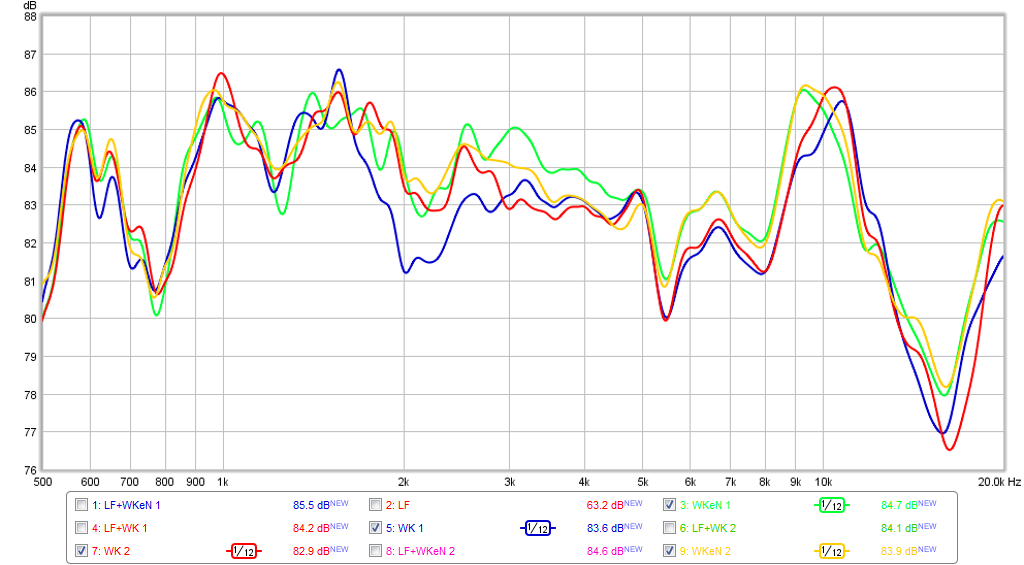
Lower resolution comparison over full range:
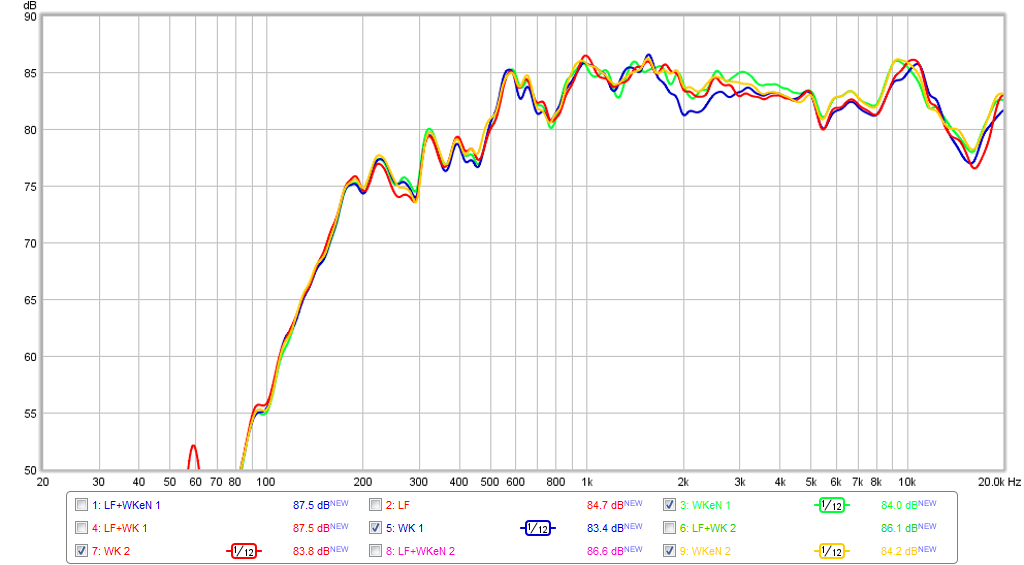
HD of Pristine 1:
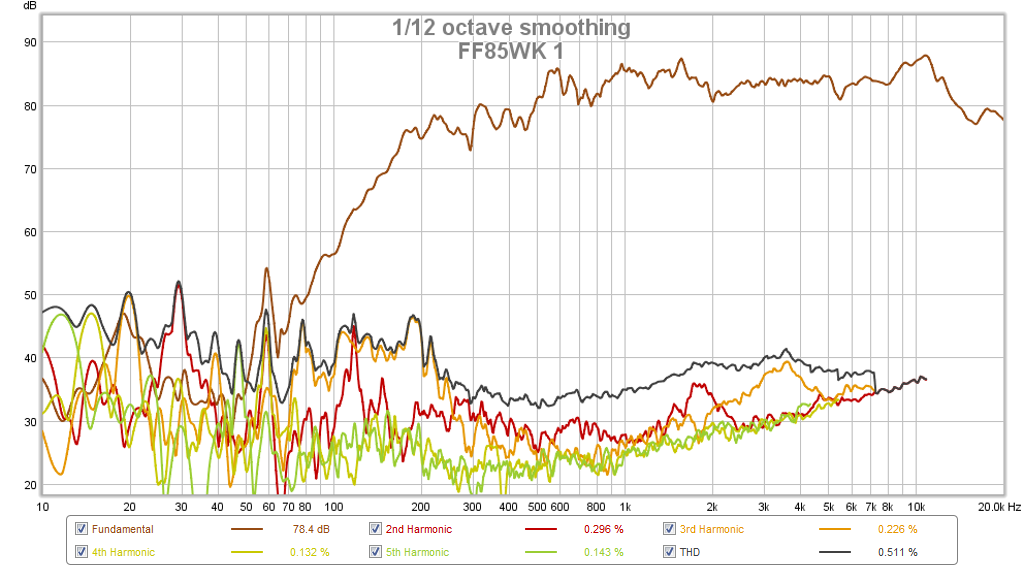
HD of Pristine 2:

HD of eN 1:
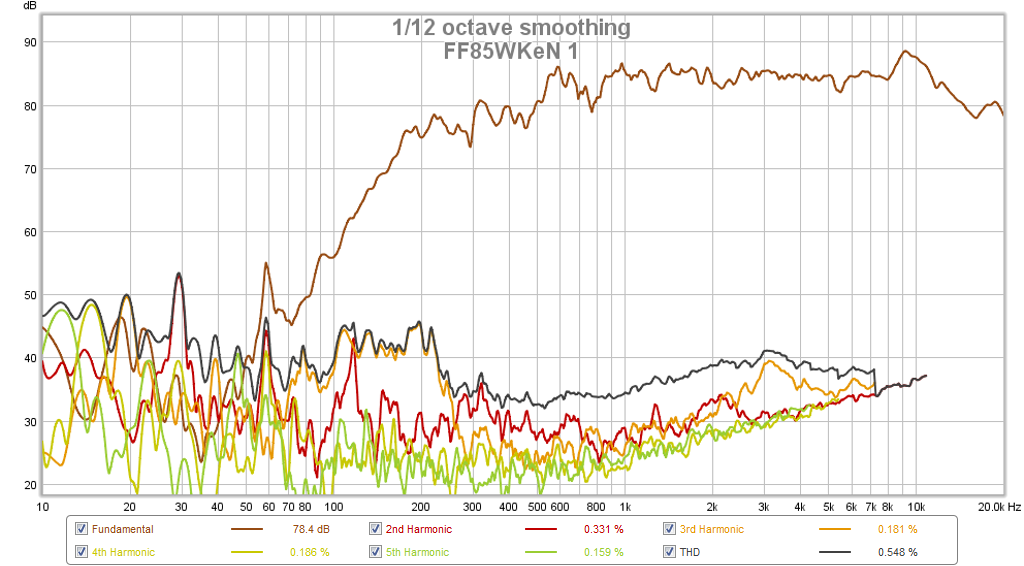
HD of EN 2:
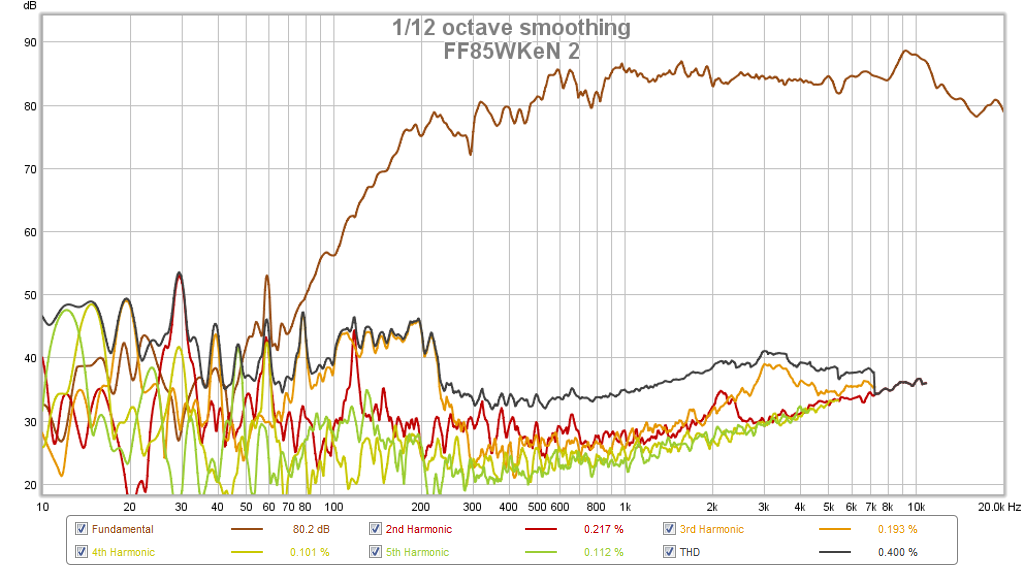
What it looks like with woofer:
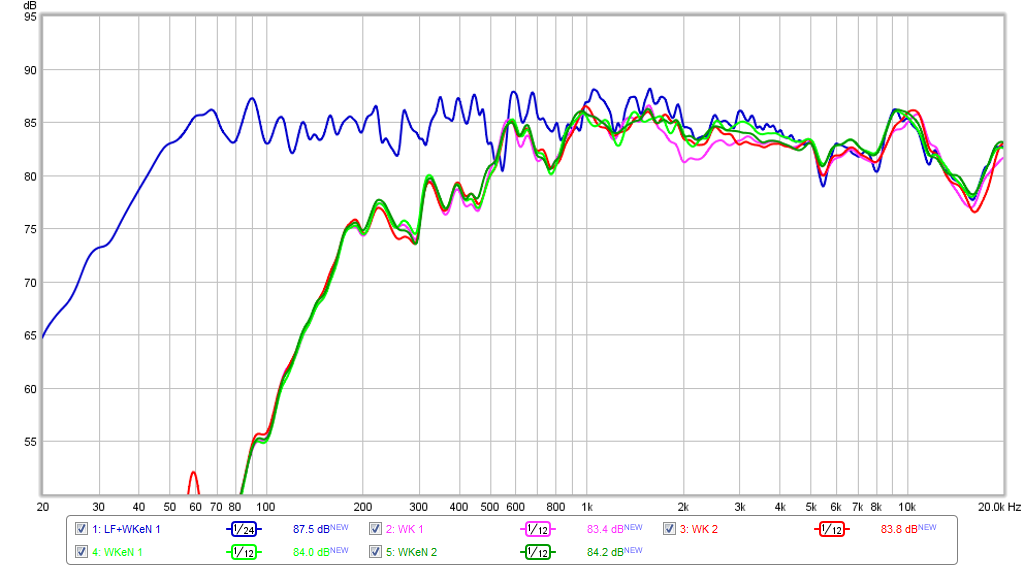
What HD looks like with woofer:
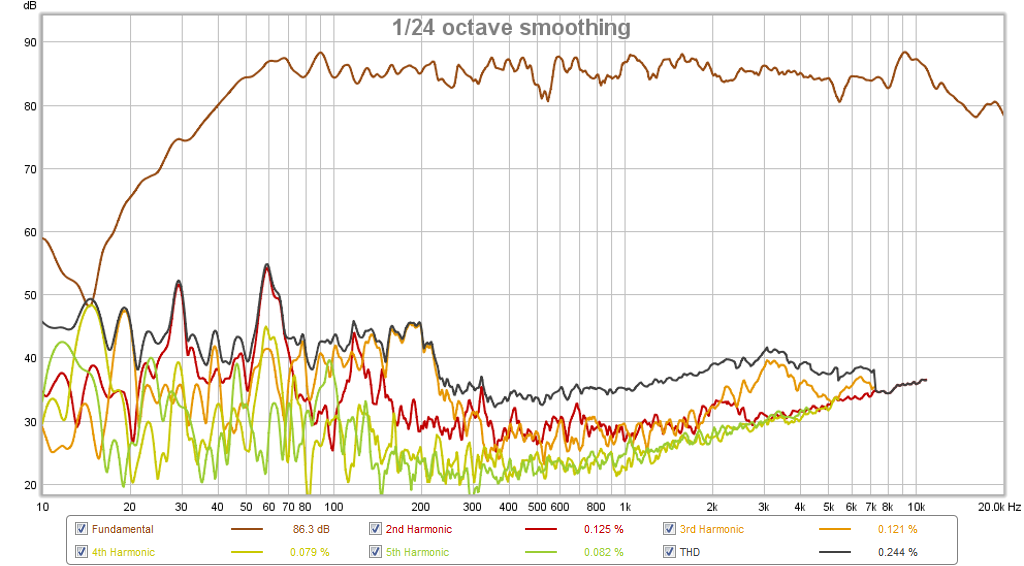
Measurements taken at 0.5m, with 2.83v excitation from UCA202 DAC driving VFET+ class AB MOSFET amp fed with 300VA 45V linear power supply, passive XO, all taken in same session.
High Resolution (1dB vertical scale) comparison:

Lower resolution comparison over full range:

HD of Pristine 1:

HD of Pristine 2:

HD of eN 1:

HD of EN 2:

What it looks like with woofer:

What HD looks like with woofer:

Attachments
-
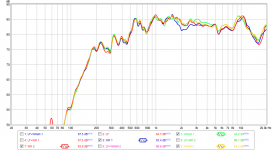 FF85WKeN-FF85WK-FR-Compare-Low-Res.png70.6 KB · Views: 3,223
FF85WKeN-FF85WK-FR-Compare-Low-Res.png70.6 KB · Views: 3,223 -
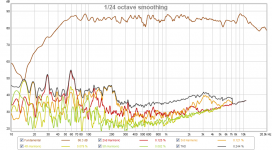 LF+WKeN1-HD.png179.3 KB · Views: 354
LF+WKeN1-HD.png179.3 KB · Views: 354 -
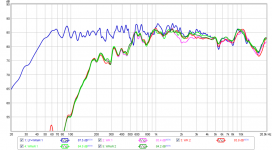 FF85WKeN-FF85WK-FR-Compare-with woofer.png87.2 KB · Views: 361
FF85WKeN-FF85WK-FR-Compare-with woofer.png87.2 KB · Views: 361 -
 WKeN2-HD.png185.9 KB · Views: 358
WKeN2-HD.png185.9 KB · Views: 358 -
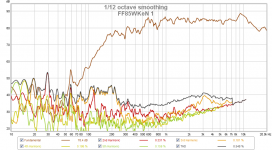 WKeN1-HD.png187.2 KB · Views: 345
WKeN1-HD.png187.2 KB · Views: 345 -
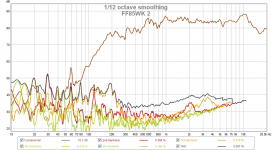 WK2-HD.png183 KB · Views: 353
WK2-HD.png183 KB · Views: 353 -
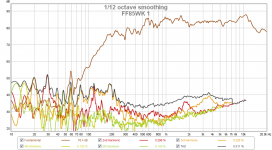 WK1-HD.png186 KB · Views: 355
WK1-HD.png186 KB · Views: 355 -
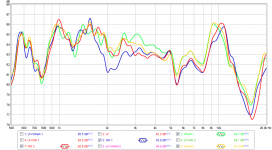 FF85WKeN-FF85WK-FR-Compare-High-Res.png119.9 KB · Views: 1,999
FF85WKeN-FF85WK-FR-Compare-High-Res.png119.9 KB · Views: 1,999
Last edited:
Here is data with 1/3rd octave smoothing, 3 cycle frequency dependent window (FDW), and 1/3rd octave FDW. The latter two involve a frequency dependent gating of the data to remove reflections that occur later in time. But I think the most instructive one is the 6 cycle FDW view as it represents a higher resolution of the effects happening at the driver and not the environment (that is, it can be corrected to some extent via passive filtering or EQ/DSP).
1/3 octave smoothing:
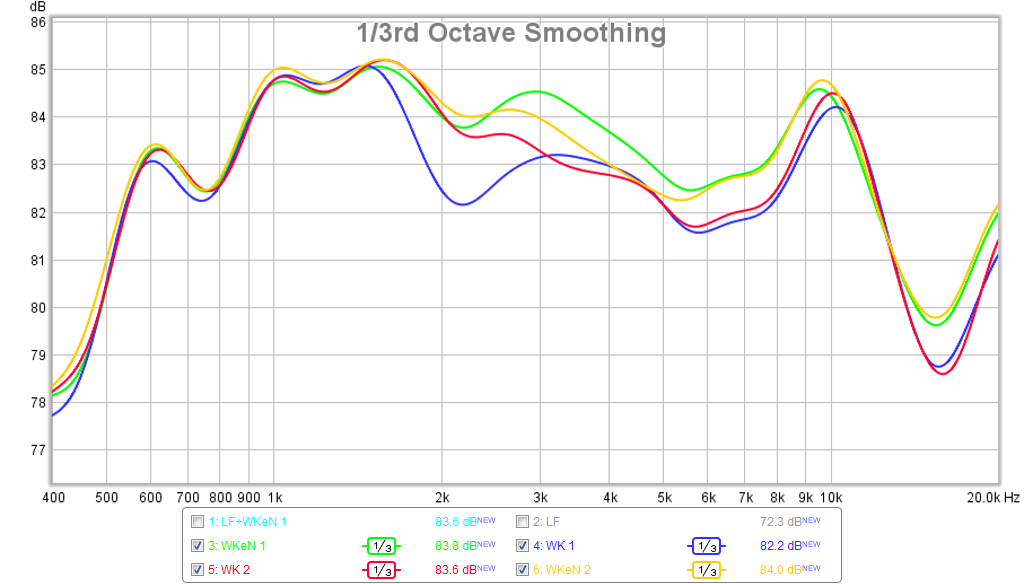
3 cycle FDW:

1/3rd oct FDW:
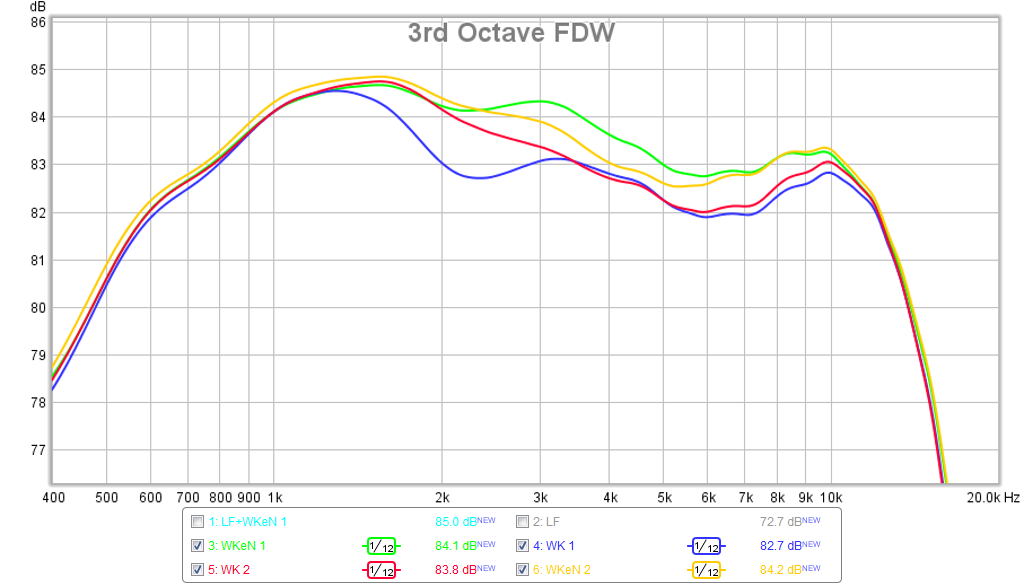
6-cycle FDW:
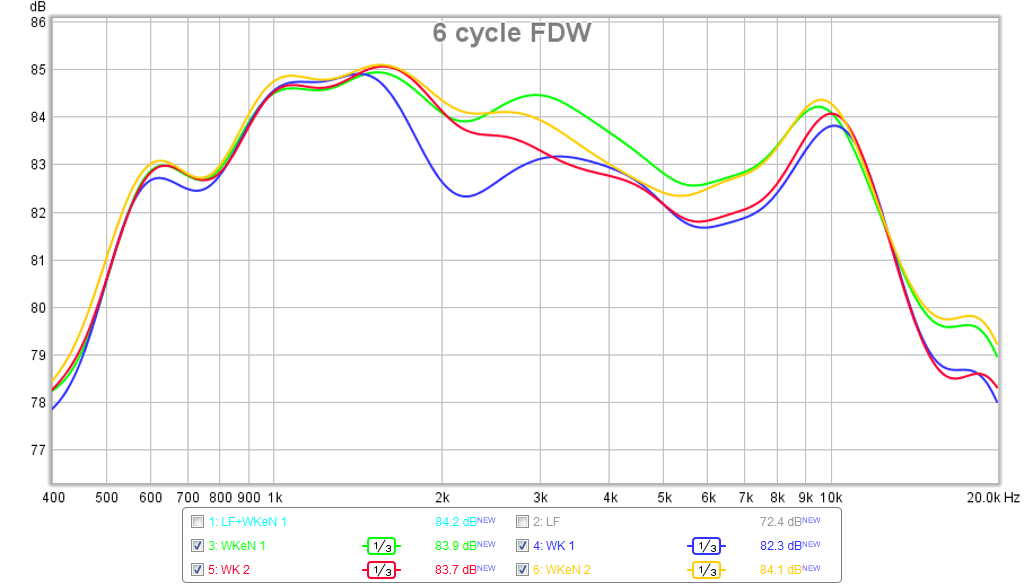
I generally use the above for making decisions about what DSP filter to apply. Although in this case it is purely passive, this could be used as the basis for designing the passive crossover without the effects of the room walls.
Looking at the above data, it appears that the first pristine driver is "out of family" with standard FF85WK in that it has a substantial 1.5dB dip at 2kHz. The other unit does not have this, nonetheless, the eNabled ones are about 1dB higher in sensitivity from about 3kHz on up.
1/3 octave smoothing:

3 cycle FDW:

1/3rd oct FDW:

6-cycle FDW:

I generally use the above for making decisions about what DSP filter to apply. Although in this case it is purely passive, this could be used as the basis for designing the passive crossover without the effects of the room walls.
Looking at the above data, it appears that the first pristine driver is "out of family" with standard FF85WK in that it has a substantial 1.5dB dip at 2kHz. The other unit does not have this, nonetheless, the eNabled ones are about 1dB higher in sensitivity from about 3kHz on up.
Attachments
Last edited:
While setting up the drivers and taking measurements yesterday, I went ahead and recorded sound clips for each. I used the existing reference tracks from Round 1 of the Subjective Blind thread plus one new track. They were recorded with the same mic at same position as shown on the above measurements. The source was converted to mono and played back in mono and recorded in mono. I think they might be just fine and we can do an ABX comparison with 320kbps MP3's - we will see. I have not had a chance to listen to them yet. But it will be a blind comparison asking which group X sounds most like, A or B? Each group has 4 tracks (2 vocals, one ACDC, one jazz).
ABX Testing Thread now open
http://www.diyaudio.com/forums/full...est-enabled-ff85wk-round-6-a.html#post4737993
http://www.diyaudio.com/forums/full...est-enabled-ff85wk-round-6-a.html#post4737993
- Status
- Not open for further replies.
- Home
- Loudspeakers
- Full Range
- Planet 10 measured improvements? FF85wk
